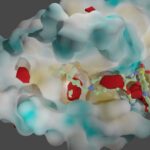Link to Pubmed [PMID] – 28922596
J Chem Inf Model 2017 Oct;57(10):2448-2462
Given the difficulties to identify chemical probes that can modulate protein-protein interactions (PPIs), actors in the field have started to agree on the necessity to use PPI-tailored screening chemical collections. However, which type of scaffolds may promote the binding of compounds to PPI targets remains unclear. In this big data analysis, we have identified a list of privileged chemical substructures that are most often observed within inhibitors of PPIs. Using molecular frameworks as a way to perceive chemical substructures with the combination of an experimental and a machine-learning based predicted data set of iPPI compounds, we propose a list of privileged substructures in the form of scaffolds and chemical moieties that can be substantially chemically functionalized and do not present any toxicophore nor pan-assay interference (PAINS) alerts. We think that such chemical guidance will be valuable for medicinal chemists in their attempt to identify initial quality chemical probes on PPI targets.





